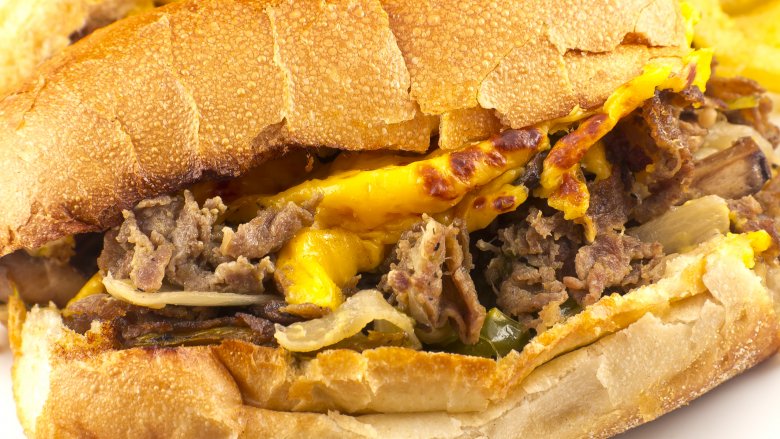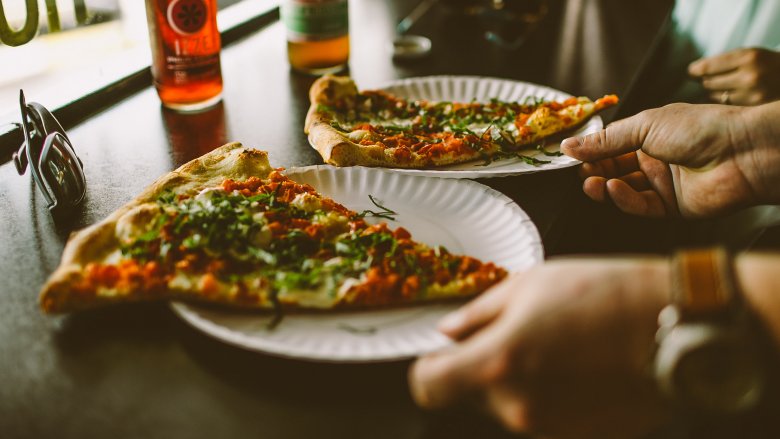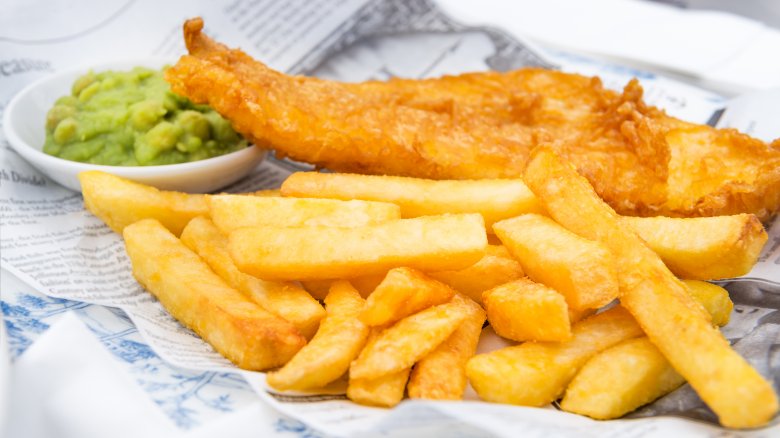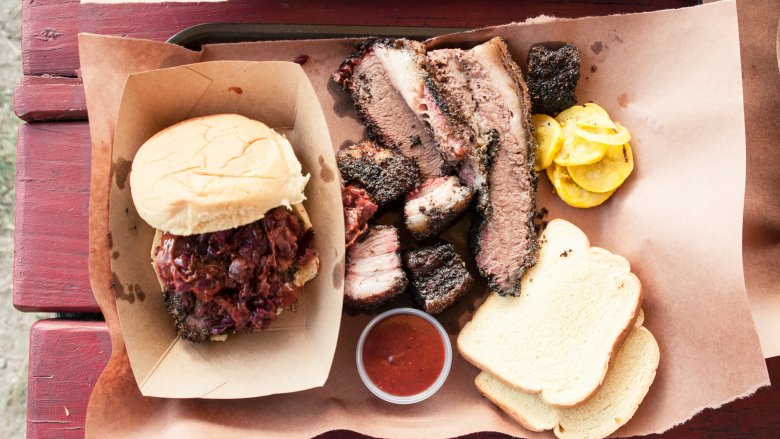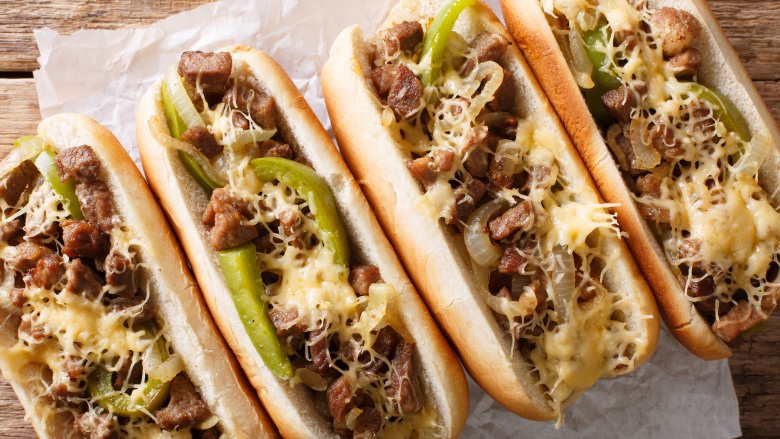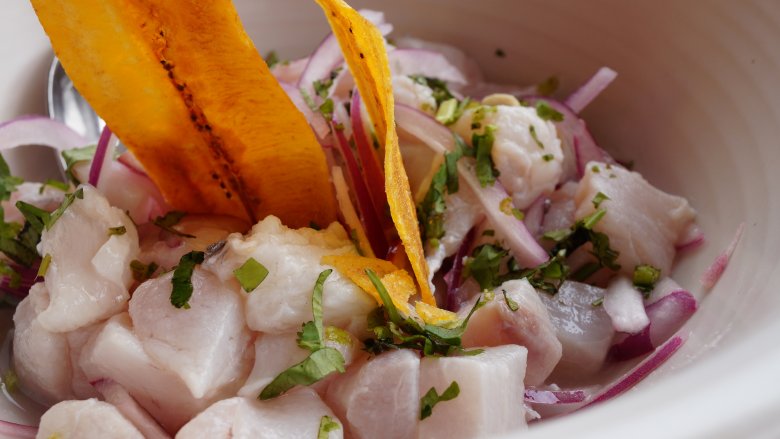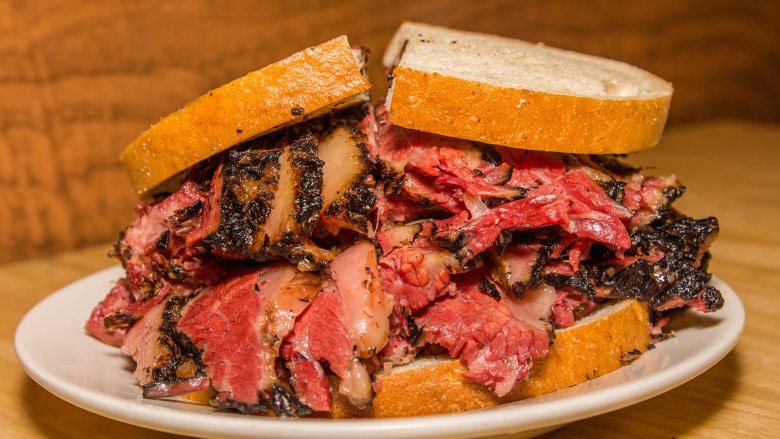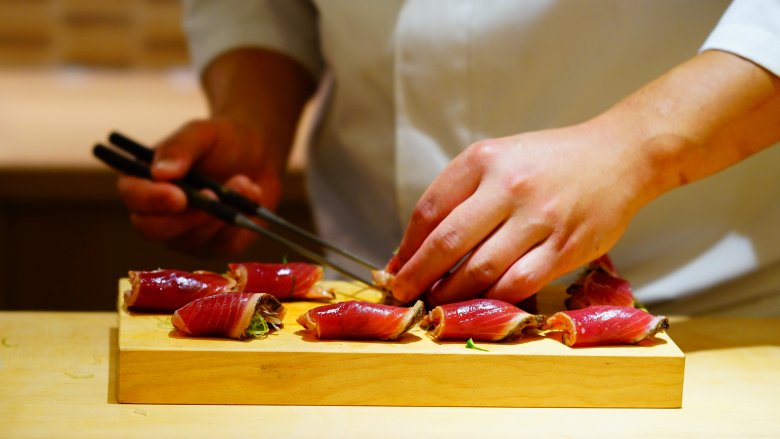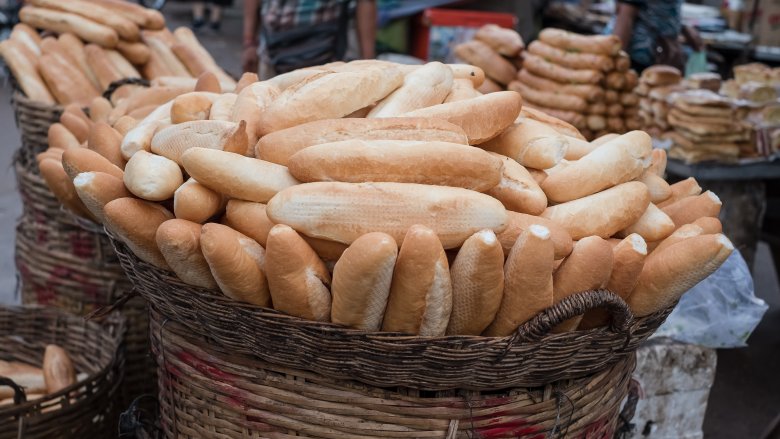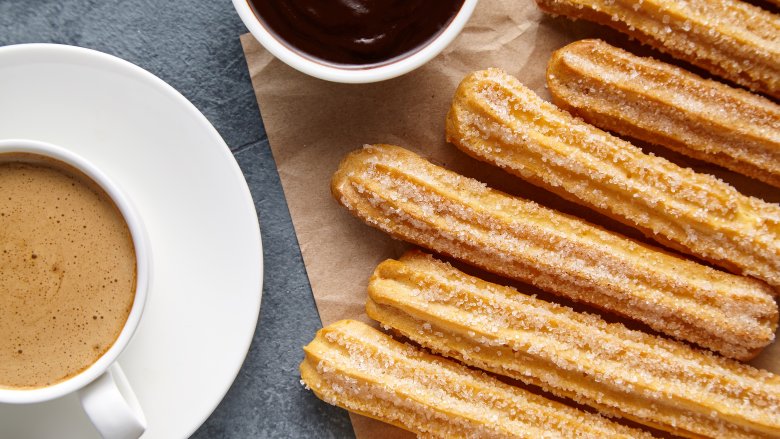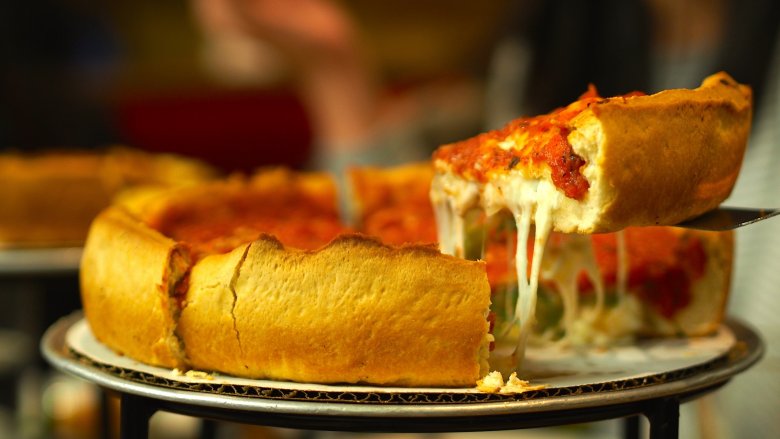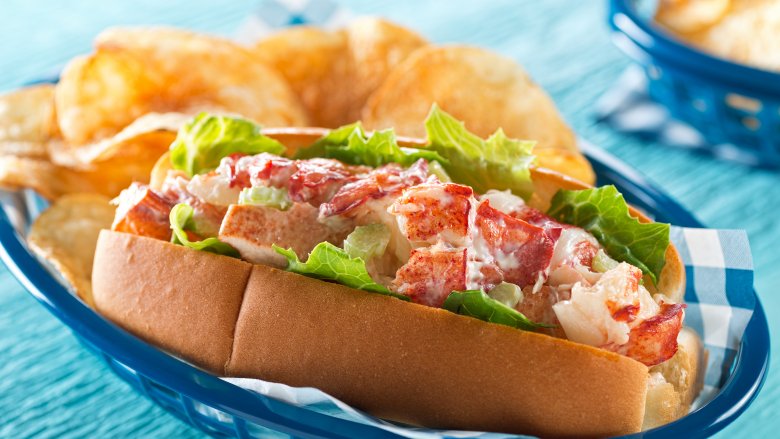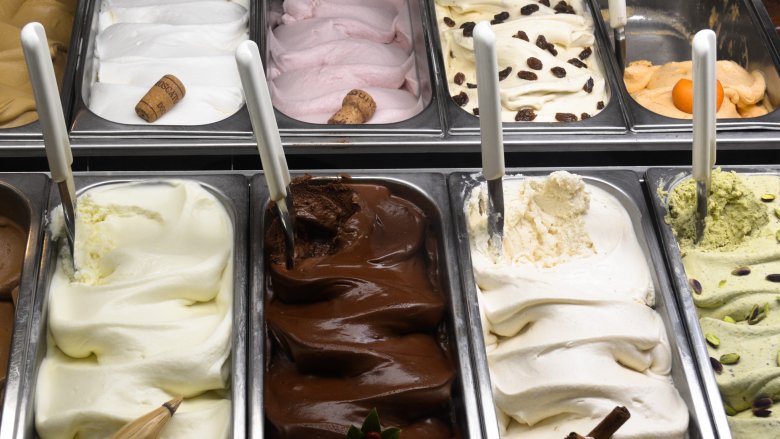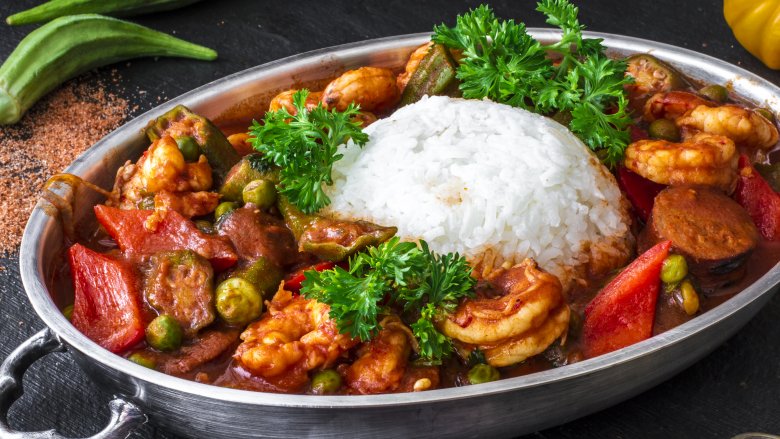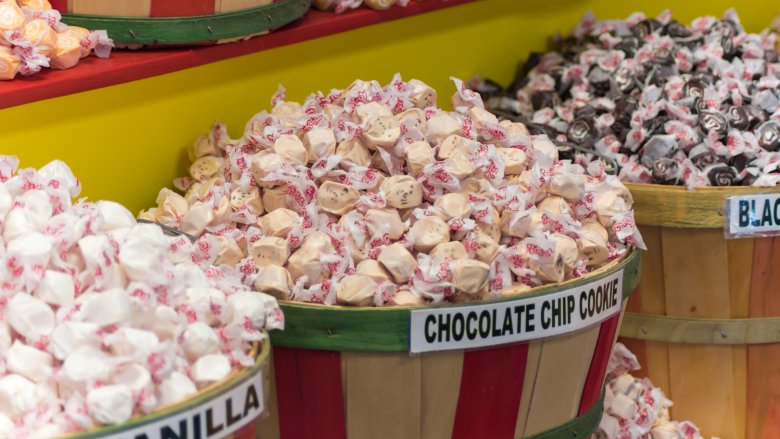Foods You Should Only Eat In One Place
Food is universal. It's a fact of life no matter where you are on Earth, for every single human on the planet, and there are a few vital tenets and rules which are applied to all forms of cooking — raw meat being mostly bad, for example, or green stuff from the ground being mostly good. When it comes to the details, however, the world's cultures couldn't possibly be further apart. Each civilization, country and region has its own way of doing things and, naturally, most of them have come up with a recipe or a dish (or a dozen) that nowhere else can quite replicate.
That's not to say people don't try, of course. It's not hard to find gelato outside Italy, fish and chips outside the U.K., or sushi out of Japan, but that doesn't mean it's really worth having. Some recipes were simply made to be eaten in the place they were invented, and anything from elsewhere is nothing but a poor copycat.
Pizza: New York City
But pizza isn't one of them. Yes, we begin with the exception that proves the rule: pizza may have been invented in Italy (specifically, in Port Alba, Naples), but today you'd be hard-pressed to argue that anywhere can do it better than New York City. Unless you're Italian, of course.
There are a multitude of reasons why pizza in New York tastes so damn good. According to many locals, it comes down to the water — the chemical composition of the local water supply has an effect on the flavoring of the pizza dough and contributes to the great taste of the finished pizza. There's also an argument to be made in favor of the ovens used in New York pizzerias, which are among the oldest in the USA, and therefore contain oodles of flavor which adds to every new pizza.
Throw in the fact that many New York pizzerias import their ingredients from Italy and the timeless popularity of the New York style of pizza, and you've got the recipe for the best in the world. Sorry, Naples.
Fish and chips: The UK
If you really need any convincing as to the cultural significance of fish and chips in the United Kingdom, just take a moment to consider the fact that the dish gets entire sections of heritage websites to itself, or that there is, completely unironically, a National Fish and Chips Award in the UK. Yes, it's a meal ingrained in the British culinary identity, arguably more so than any other. Invented some time in the 19th century, fish and chips has supported the British populace through the Industrial Revolution, the rise of the Empire and the Second World War — where it was one of the few things not rationed by the government.
Every year, the British consume millions of servings of fish and chips and there are somewhere around 10,000 fish and chip shops across the UK. It's a dish largely unheard of elsewhere in Europe, and the only places you'll get it in the US are likely to be no more than pitiful imitations of the real thing. For real fish and chips, you need fresh-caught haddock or cod from the Atlantic or North Sea, and you need a Brit behind the counter who knows what to do with it. Accept no substitutes.
BBQ: Texas
There are a few different styles of barbecue in the United States, with Kansas City, Memphis, South Carolina and North Carolina being among the most well-known. The true heart of this American tradition, however, lies in Texas.
Barbecue is practically religion in Texas. As of 2015, it led the nation in numbers with well over 2,000 barbecue joints across the state, many of which are highly successful — and its popularity is only growing. What makes Texas' version of the tradition so great, according to Barrett Black (of Black's BBQ), "isn't what we put in our barbecue, it's what we don't put in our barbecue." That means a low tolerance for heavy sauces, a touch of salt and pepper for seasoning and hand-reared, long-cooked smoked cuts of beef. Simplicity is key.
Because the recipes are so simple, Black claims, it's harder to hide your mistakes — and skill is more of a factor in determining the quality of your food. It's probably fair to assume that, consequently, the Texans have honed that skill into something truly special.
The cheesesteak sandwich: Philadelphia
Well, it's called the Philadelphia Cheesesteak for a reason. The legendary sandwich (made up of beefsteak and melted cheese in a hoagie roll, if you're not familiar) is as synonymous with Philly as the Eagles, the Liberty Bell and Danny DeVito. Because of the relative simplicity of the sandwich, it should be no surprise that many cities beyond have attempted to replicate the cheesesteak, but you need to head to its birthplace for the real thing.
Perfecting the cheesesteak sandwich is a surprisingly complex affair, requiring an ability to deftly balance the flavors, textures and the so-called "drip factor." Naturally, the Philly locals have this down to a T. They've become so adept at creating the sandwich that they've even managed to cut down on valuable talking time when ordering: any variation on the words "one," "whiz," "provolone," "with," and "without" are all you need to get your order in. They made a language for it. Trust them.
Ceviche: South America
On the surface, ceviche is a type of seafood often found in South America or South American restaurants around the world. It's made from fresh, raw fish cured in citrus juices and spiced with peppers. Ceviche is a style of cuisine that constitutes a deep and integral part of South American gastronomy — and it's genuinely delicious to boot.
What you'll find in your local ceviche restaurant (you know the one) isn't a good representation of what ceviche can be, however. More and more, South Americans are preparing all sorts of foods in the style, from vegetables to other meats — including alligator — to soy. The need to innovate has gripped the continent, and every aspect of ceviche is constantly being reinvented. Visit South America and you'll find no two bases, ingredients or sauces are the same. There are now so many combinations of ceviche that you could live in South America for decades and still find always find something new to try.
Pastrami: New York... or LA
A good pastrami sandwich is something to be truly proud of. We challenge you to go look at any image of one, read any writing about them or, hell, even just imagine one without your mouth watering. Proper pastrami between two slices of rye bread, with melted cheese and hot mustard with a pickle or two on the side. It's the ambrosia of the deli.
New York City is home of the pastrami sandwich, and has been since its creation over 100 years ago. In recent years, however, a rivalry has developed between NYC and Los Angeles over who can create the best version of the recipe. Leading the charge for each city is Katz's Delicatessen and Langer's, respectively. Katz's has got the better meat, according to taste tests, while Langer's double-baked rye bread is the stuff of legend. Critic Jonathan Gold, who writes for the LA Times (we'll let you decide whether that makes him a trustworthy source, here) claims that Langer's pastrami is better than anything he's ever had in New York.
Jury's out on this one, then.
Sushi: Japan
Sushi might be Japan's most famous food, and it's certainly the most prolific world-wide. Almost every town in America and Europe has a sushi place somewhere to be found, and those delicious little morsels of fish, vegetables and rice have managed to capture the hearts of people all over the planet.
At this point, it'll come as little surprise to learn that, if you want the best sushi around, you've got to haul yourself over to Japan. There are a number of differences between Japanese sushi and what we're all used to — firstly, sashimi (the thinly-sliced pieces of fish) are more commonly found than rolls, which are an invention tailored to Western tastes. Rather than being wrapped in rice, the sashimi is served with or on top of it. The taste of Japanese sushi is also more delicate and finely-balanced, whereas Western sushi is bolder and more based around aesthetic value. Finally, the Japanese are more inclined to use fresh fish with their sushi, whereas, in the west, freshly-caught fish tends to go toward Western dishes (hello, fish and chips) while the stuff that comes through sushi restaurants tends to be frozen. Put it all together and we won't blame you if you want to start checking out air fares to Tokyo.
Baguettes: France
It's almost a cliche — the sophisticated Frenchman, walking the streets of Paris with a baguette in hand. You half want to make him a mime, shower him in garlic and send him to war with the English, don't you? The baguette is a staple of the French cultural identity, as viewed from abroad, and for good reason, too: it was invented there. Baguettes as we know them have been around in France for hundreds of years and were perfected with the development of the steam oven. Now, they're utilized by restaurants, cafes and sandwich-makers all over the country.
But it's not just the heritage that makes French baguettes so good. A number of other factors are also involved — government regulations on how bread is made, a low ash content in the flour and a great appreciation for its uses among the population have all helped make French bread the best in the world.
Churros: The Iberian Peninsula
Another case of going straight to the source, here — churros are a decidedly Iberian creation, and, if you want the real thing, it is to Iberia that you must go. The legendary sweet street food was, depending on who you ask, either the brainchild of Spanish shepherds or the discovery of Portuguese sailors who traded with China. Either way, there can be no doubt that churros are one of the region's most renowned foods.
European churros are minimalist, made simply with sunflower oil and served without any of the garnishes (such as Nutella, cream or sugar) that you'll find in the Americas. They're eaten as a breakfast food, as a snack and even as a hangover cure, and are highly prolific in all walks of Spanish and Portuguese life. Every corner of the peninsula has its own take on the churro and they all approach their recipes with the utmost seriousness. Nowhere else in the world are they loved quite so much.
Coffee: Italy
Coffee is an international phenomenon, there's no doubt. The beans come from South America, Asia, Africa and beyond, it's drunk around the world and pretty much everywhere has its own way of doing it. There are so many arguments for so many different places having the best coffee on the planet. Spoiler alert, though: It's Italy.
Forget your Starbucks and your hipster artisanal guff; put down those sickly-sweet cinnamon monstrosities and your syrupy Frankenstein creations — the best coffee is the espresso, and the best espressos are in Italy. The beans are roasted lighter, giving a more complex taste, and the finished product is enjoyed on-the-go or at the counter of a bar. The perfect espresso should be simple, delicious and never, never drunk after 11 a.m. That's how they do it and, without wanting to go all Roman Emperor on you, that's how you should do it, too.
Deep-dish pizzas: Chicago
Like the Philadelphia cheesesteak, the deep-dish pizza is one of the few regional specialities to have been blessed with the name of its home. That should give you a clue as to the importance of its roots. The Chicago deep-dish, to give it its proper name, is more pie than pizza — enough so to make any New Yorker blush, never mind an Italian. Take it for what it is, though, and you'll find it to be a treat unto itself.
This peculiar breed of pizza originated with Italian immigrants who settled in Chicago in the early 20th century. It was supposed to be the Italian-American variant on the Italian pizza, and it quickly became a Chicago icon. Pizzeria Uno, the home of the deep-dish, still exists today. Time is the best teacher here, and it's safe to say that decades of practice have made Chicago's pizzerias the stalwarts of the deep-dish.
Lobster rolls: Maine
The lobster roll is a staple of New England's culinary scene. And just looking at them, it's not hard to understand why. Lobster, butter or mayonnaise, lemon juice and a bit of salt and pepper served on a grilled bun with fries — some might argue it's the ultimate way to eat lobster, and we'd be hard-pressed to disagree.
Now, New England has two variations on the lobster roll: one from Connecticut and one from Maine. The differences are subtle — in Maine, the meat is served cold and tossed with mayonnaise, tarragon and celery, served on a Frankfurter roll. Its rival uses butter rather than mayo and generally includes no dressing. But where's best?
Maine. Sorry, Connecticut, but the golden rule with seafood is that the closer you are to the source, the better it's going to taste. Because the warming of the oceans is pushing lobster populations into the more northerly areas of New England, Maine is now the ideal place to catch and eat lobster. Naturally, the rolls are going to be better there, too.
Gelato: Italy
Gelato is a little different from the ice-cream most Americans know and love. Ice cream, generally, is colder, milkier and more full of butterfat than gelato, giving the latter a smoother, silkier and more vibrant taste. It dates back to the 16th century, where it flourished among the locals of regions such as Sicily and Florence. Since then, it has become popular the world over and remains today was one of the foods for which the Italians are best known.
Gelato is common all across Europe — especially in the Mediterranean — but Italy is its home. If that's where you're headed, there are a few tell-tale signs to look out for if you're after really great gelato: it's usually served in metal rather than plastic, it should have muted colors (because of its natural ingredients), and usually doesn't come in over-the-top flavors, such as bubblegum. Look out for the understated stuff, make sure the ingredients are fresh and simple, and you're on the right path.
Gumbo: New Orleans
The reason you don't want to be having gumbo anywhere other than New Orleans comes down to one word: history. Gumbo is the ultimate in Louisiana cooking. It is said to be the culmination of the coming together of a mish-mash of different food cultures, with various aspects of gumbo deriving from African, Native American and French cooking styles. Described in an 1885 cookery book as an "occult science," it can be made with a variety of meats but, in its Louisiana form, contains the three holy trinity vegetables of celery, bell peppers and onions.
New Orleans is a city steeped in as diverse a history as gumbo itself. Not only this, but its reputation for its culinary culture and the sheer choice of gumbos on offer all around town mean there's simply nowhere else to be for it. Walk into any home or restaurant on any street and you'll find someone capable of rustling up something truly special.
Saltwater taffy: New Jersey
Saltwater taffy — which, if you don't know, is a kind of chewy, fruit-flavored confection that, today, is known for its presence on the boardwalks of seaside towns up and down America — was first produced at the beginning of the 19th century in Atlantic City. Since then, it's become something of an icon for New Jersey, who even made it the state's official candy back in 2014. The name is said to come from a local shopkeeper whose wares were hit by flooding, and marketed the taffy he was selling as "saltwater taffy." Over the ensuing centuries, it became an intensely popular treat all over the US, and helped put New Jersey on the (snack) map.
Today, you can probably find it anywhere in America, but let's just call that taffy — if it's real saltwater taffy you want, as mischievously rebranded as it was back in the 1800s, you've got to go to where it started out.
